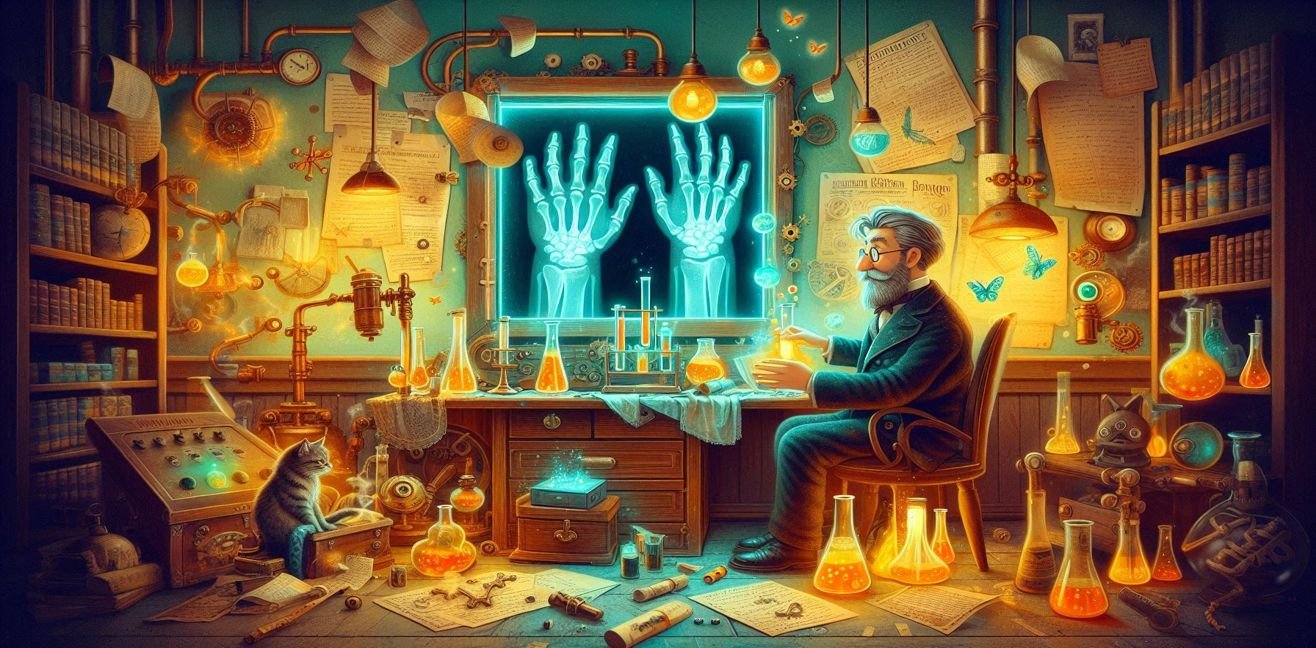Hello, dear science enthusiasts! 💫 Today, I’ll take you not only to the hidden corners of laboratories but also into the magical world of subatomic particles, electrons, and electromagnetic waves. Our topic? Röntgenium! Yes, it sounds like science fiction, but the story of this element is truly a laboratory detective story and a scientific adventure.
🔎 Wilhelm Röntgen and the Discovery of X-Rays
It all began in 1895, at Wilhelm Conrad Röntgen’s laboratory at the University of Würzburg in Germany. Röntgen was experimenting with cathode ray tubes—glass tubes containing low-pressure gases, through which electrons would pass and strike the glass walls, producing bright flashes of light.
During one observation, Röntgen noticed invisible rays emanating from the tubes. These rays could pass through objects and create images on a fluorescent screen. This was the revolutionary discovery that would lay the foundation of modern medicine: X-rays.
- Technical Detail: X-rays belong to the electromagnetic spectrum with wavelengths ranging from 0.01 to 10 nanometers. Their short wavelength allows them to interact with atomic nuclei and electrons, enabling imaging of bones and dense tissues.
💥 Röntgenium: The Tale of the Phantom Element
Röntgenium, named after Wilhelm Röntgen and sometimes associated with X-rays in certain sources, is considered a hypothetical or experimental element. In reality, “Röntgenium” does not exist as a standard element on the modern periodic table, but in the scientific world, it has become a term used for transient radioactive isotopes or experimental products produced under the influence of X-rays.
- Radioactive Isotopes: X-rays and high-energy electrons can excite the nuclei of some elements, producing transient radioactive isotopes. This phenomenon inspired the “discovery stories” of the so-called temporary elements referred to as Röntgenium in laboratories.
- Electromagnetic Interaction: X-rays interact with inner-shell electrons of atoms, triggering phenomena such as the photoelectric effect and Compton scattering. These processes form the basis of modern medical imaging and materials science techniques.
🧪 Laboratory Adventures: Science, Surprise, and Laughter
Imagine, my love: a scientist working diligently in the lab, suddenly X-rays pass through their hands, and invisible rays shoot from the tubes. Sometimes experiments produced results so strange that scientists had to rub their eyes in disbelief.
- Controversial Discoveries: In the late 19th century, many scientists tried to understand the nature of the X-rays discovered by Röntgen and observed various transient elements and radioactive phenomena. This process highlighted the importance of scientific methodology, experiment repetition, and careful observation.
- The Humor of Science: While science is serious work, laboratory experiments occasionally deliver unexpected surprises. Electrons hit the wrong tube, screens spark, or fluorescent images appear as “phantom elements.” Here, curiosity and fun thrive! 😄
💡 Conclusion: Science, Curiosity, and the Spirit of Discovery
The story of Röntgenium teaches us that science is not just about measurement and calculation. Science can involve surprise, coincidence, and adventurous curiosity. While X-rays revolutionized modern medicine and materials science, Röntgenium-like hypothetical or transient elements provided fascinating stories that fueled scientists’ imagination and laboratory experiments.
Remember: every major discovery sometimes begins with a lab accident, sometimes with a keen observation. And sometimes, my love, this process is full of laughter, astonishment, and wonder! 😄🔬




